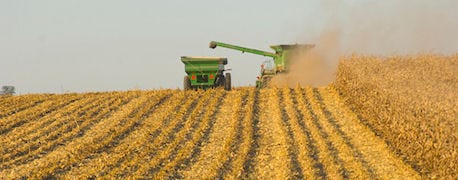November 5, 2014

By George Silva
In Michigan, corn and soybeans are being harvested and grain is being taken to the storage or elevator. How much nutrients are being removed by this grain, particularly the three major nutrients: nitrogen (N), phosphorus (P) and potassium (K)? Nutrient removal by harvested portion of grain crops is an important aspect for farmers when deciding fertilizer rates for next year.

Calculate Nutrient Removal Rates By Grain Crops To Decide Fertilizer Rates
Nutrient removal amounts can be easily calculated by multiplying the nutrient removal rate per bushel of yield (shown in table) by actual yield. For example, a 150-bushel-per-acre corn will remove 135 pounds per acre N, 56 pounds per acre P2O5 and 41 pounds per acre K20. At current fertilizer prices, total N, P and K nutrient value in the grain would be about $112 per acre. Likewise, a 40-bushel-per-acre soybean crop will remove 152 pounds per acre N, 32 pounds per acre P2O5 and 56 pounds per acre K20. As yields get higher, more nutrients are removed from the field.
Nutrient removal rates per bushel by three Michigan grain crops
Crop | Unit | N pounds/bushel | P205 pounds/bushel | K20 pounds/bushel |
Corn | Bushel | 0.9 | 0.37 | 0.27 |
Soybean | Bushel | 3.8 | 0.80 | 1.40 |
Wheat | Bushel | 1.2 | 0.63 | 0.37 |
According to Michigan State University Extension's build-up, maintenance and drawdown approach, the soil test P and K should ideally be in the maintenance range. When this level is attained, farmers can avoid any buildup or drawdown scenarios simply by adding the total nutrient removal rates of the crop to be planted. Soil testing every three years would enable farmers to monitor the changes in the P and K levels. Please refer to MSU Extension publication E2904, "Nutrient Recommendations for Field Crops in Michigan," for guidelines on MSU fertilizer recommendations and nutrient removal rates of Michigan field crops.
Soybeans as a legume crop can meet its own N needs under favorable growing conditions by symbiotic fixation with bacteria. So no fertilizer N is recommended on soybeans. Soybeans also remove less P and more K in a year compared to corn.
Whether you are planting wheat or contemplating fall P and K applications for corn and soybeans, nutrient removal rates are an important consideration in making fertilizer rate decisions. As the nutrient removal rates are a function of yield, an over-estimated yield goal will lead to over application of fertilizer and higher production costs.
Silva writes for Michigan State University Extension
You May Also Like




